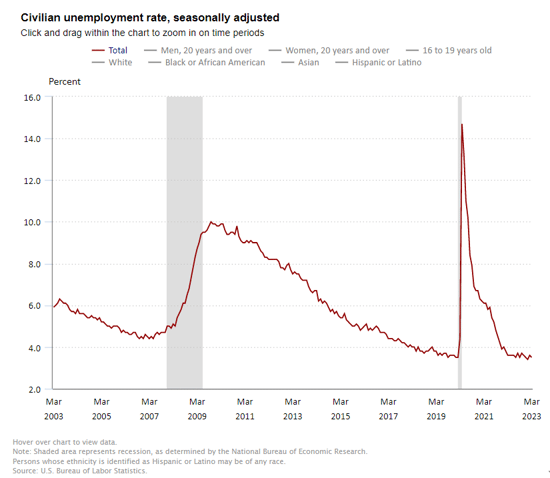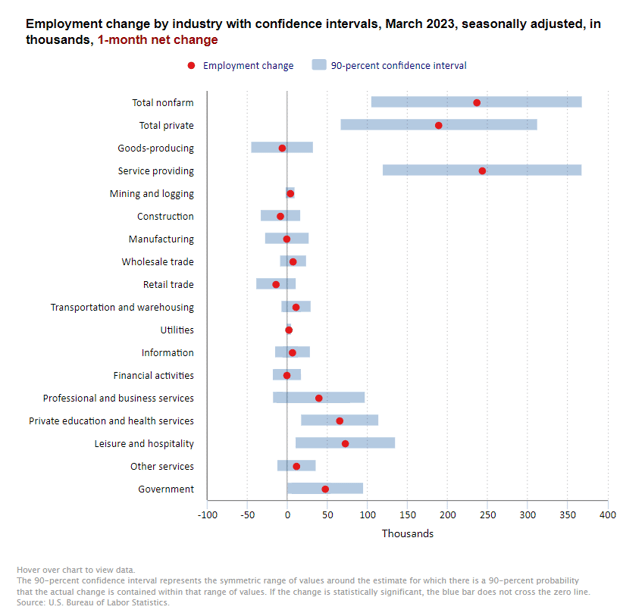The Bureau of Labor Statistics reported that the unemployment rate slipped back to 3.5% in March from 3.6% in February, but up from 3.4% in January, which was its lowest level since 1969. It has been hovering in a narrow range for many months now. Separately, the BLS also reported that nonfarm payrolls rose by 236,000 in March 2023, below the monthly pace of 334,000 over the prior six months, but still strong. Market expectations had called for a gain of 230,000 jobs. Revisions subtracted 17,000 positions to total payrolls in the previous two months.

Today’s report shows the labor market remains relatively strong with the economy still creating jobs at a solid, albeit, slowing pace. That said, the slowing in average hourly earnings and other reports on the jobs market suggest an adjustment in the labor markets is starting to occur. The general softening in the labor force will be welcome news to the Fed which is watching for signs that inflationary pressures are dissipating. A softer labor market should help to ease wage pressures and prevent a wage/price inflationary spiral from occurring.
Indeed, earlier this week, the Labor Department released the Job Openings and Labor Turnover report (JOLTS) that showed that the demand for labor is starting to cool down a bit. The report showed that there was a drop in job openings to 6.0% in February from 6.4% in January driven by declines in professional services, education, and leisure. The vacancy-to-unemployment ratio which the Fed cites as a measure of excess labor demand fell to its lowest level since late 2021. And the job quits rate inched higher. Job layoffs remained low, however.
Note that the March report comes too early to capture much impact from the recent banking sector woes, with the troubles at SVB not coming to a head until near the end of the survey period.
Today’s report showed that employment in health care rose by 34,000 in March, compared with the average monthly increase of 54,000 over the past six months. Employment in nursing care facilities grew by 3,400 jobs from last month and 50,100 from year-earlier levels and stood at 1,392,700 positions. Jobs increased by 4,300 positions in CCRC and assisted living facilities and were up by 59,800 from year-earlier levels to 944,000 jobs.
In the household survey conducted by the BLS, the jobless rate slipped 0.1 percentage point to 3.5%, down from 3.6% in February. Both months’ unemployment rates were well below the 14.7% peak seen in April 2020. The underemployment rate was 6.7% versus 6.8% in February.
Average hourly earnings for all employees on private nonfarm payrolls rose by $0.09 in March to $33.18. This was a gain of 4.2% from year-earlier levels, lower than in recent months.
The labor force participation rate inched up to 62.6% in March, up from 62.5% in February, which followed three prior monthly increases in the rate. It was below the February 2020 level of 63.3%, however.
The number of long-term unemployed (those jobless for 27 weeks or more) was 1.1 million in March. These individuals accounted for 18.9% of all unemployed persons.
Among the major worker groups, the March unemployment rates were 3.1% for adult women, adult men (3.4%), teenagers (9.8%), Whites (3.2%), Hispanics (4.6%), Blacks (5.0%), and Asians (2.8%).

About Beth Mace
Beth Burnham Mace is a special advisor to the National Investment Center for Seniors Housing & Care (NIC) focused exclusively on monitoring and reporting changes in capital markets impacting senior housing and care investments and operations. Mace served as Chief Economist and Director of Research and Analytics during her nine-year tenure on NIC’s leadership team. Before joining the NIC staff in 2014, Mace served on the NIC Board of Directors and chaired its Research Committee. She was also a director at AEW Capital Management and worked in the AEW Research Group for 17 years. Prior to joining AEW, Mace spent 10 years at Standard & Poor’s DRI/McGraw-Hill as director of its Regional Information Service. She also worked as a regional economist at Crocker Bank, and for the National Commission on Air Quality, the Brookings Institution, and Boston Edison. Mace is currently a member of the Institutional Real Estate Americas Editorial Advisory Board. In 2020, Mace was inducted into the McKnight’s Women of Distinction Hall of Honor. In 2014, she was appointed a fellow at the Homer Hoyt Institute and was awarded the title of a “Woman of Influence” in commercial real estate by Real Estate Forum Magazine and Globe Street. Mace earned an undergraduate degree from Mount Holyoke College and a master’s degree from the University of California. She also earned a Certified Business Economist™ designation from the National Association of Business Economists.
Connect with Beth Mace
Read More by Beth Mace